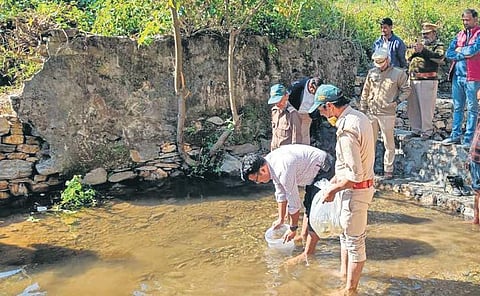

UTTARAKHAND: Dharam Singh Meena, divisional forest officer of Narendra Nagar forest division in Uttarakhand, has earned the moniker ‘Bhagirathi Ji’ because of his stellar contribution to rejuvenate the Heval river. Over one lakh people in 23 villages and Chamba town get their drinking and irrigation water from the river.
Factors aggravated by anthropogenic activities – mining, release of industrial waste, smelting of ore, incineration of fossil fuel, particularly coal – had forced the river to dry up. “The sudden increment in runoff water during monsoon, becomes catastrophic for farmers in the area. We started a project in 2018 to rejuvenate dying springs, streams, and the riverbed,” explains the Indian Forest Services (IFS) officer. “Our main objective was to restore or create near natural conditions to revive the springs (the main water source),” says Meena, who holds a Masters in Forest Products from the University of Horticulture and Forestry, Nauni, Solan, Himachal Pradesh.
Meena launched the project five days after his posting in the division. The project involved training, survey and outreach with the help of NGOs and institutions such as the National Institute of Hydrology, Roorkee and IIT-Roorkee, and Centre Soil and Water Conservation, Research & Training Institute (CSWCRT), Dehradun.
“We had a colleague VD Saklani from Saklana village, also known as ‘Vriksh Mitra’ (Hindi for ‘a friend of trees’). He notified me about the water scarcity in the Holm areas above the river, besides Gangotri
National Highway. The belt is famous for vegetables and spices,” recalls Meena.
Most of Heval river flows through the reserve forest area with a watershed area of 25466.33 hectares, which means no interference from any other department. In time, Meena decided to do his bit for the river and launched the ‘Heval River Rejuvenation’ project.
The Heval, at an altitude of over 8,000 feet, is one of the tributaries of the Ganga and is formed by confluence of small streams in Tehri district of the hill state. “An innovative geo-hydrological study based on spring-shed technique was adopted. In this, aquifer recharge is the main objective and the revival of springs in the entire landscape is the key. This technique has shown encouraging results as we completed revival work in 66 springs and 17 streams,” says Meena.
Mountain springs emanating naturally from unconfined aquifers are the primary source of water for rural households in the Himalayan region. Due to the impacts of climate change on precipitation patterns such as a rise in rainfall intensity, reduction in its temporal spread, and a marked decline in winter rain, coupled with other anthropogenic causes, the problem of dying springs has become common across the Himalayan region.
The project resulted in substantial additional recharge of water contributing to 865.86 lakh litres of groundwater, increase in water discharge level in 23 springs, afforestation of 697 hectares with plantation of around 9,88,400 trees and shrubs suited to local climes. All this work generated employment in 34 panchayats.
Gunogi Pradhan, Kheemanand Kothari, Village Pradhan of Gunogi, said, “Sahab hamare liye Bhagirathi ban kar aaye (sir has come here as the seer Bhagirathi). He has solved the water scarcity problem.” Meena has also developed an advanced system of forest fire management that is being used across the country. “This model provides real-time forest fire information; even smallest fires can also be detected. With an automatic fire alert system, forest fires are detected, formulated and then information is disseminated directly to the forest guards through SMS.”